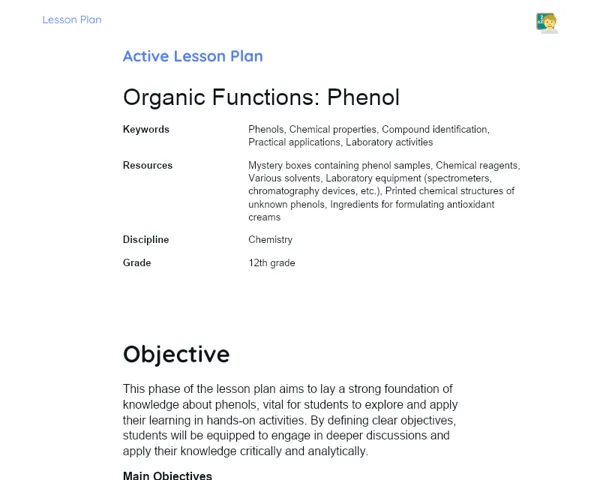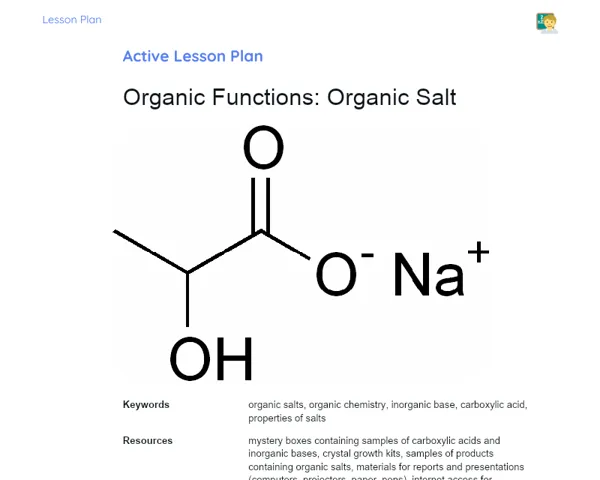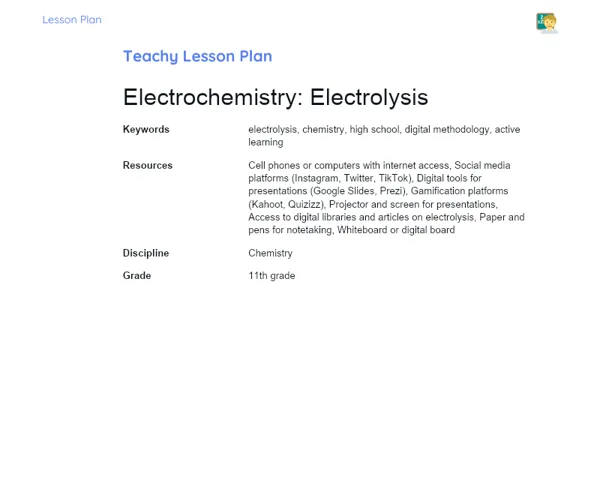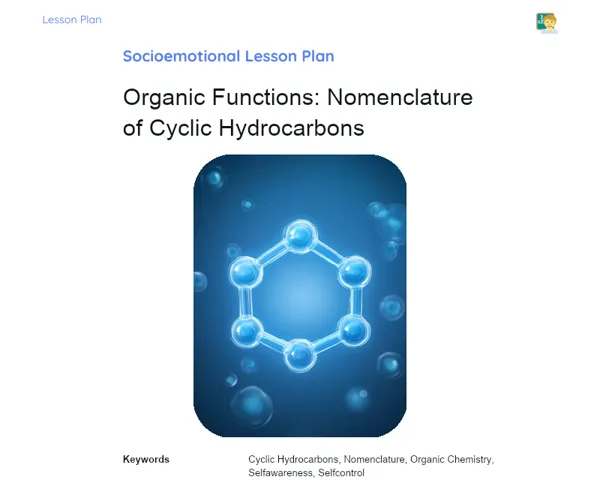Lesson Plan | Socioemotional Learning | Atoms: Energy Levels and Sublevels
| Keywords | Atoms, Energy Levels, Energy Sublevels, Electronic Distribution, Electronic Configuration, Energy of Electrons, Mindfulness, Self-awareness, Self-control, Responsible Decision-Making, Social Skills, Social Awareness, RULER, Socio-emotional Methodology, Interactive Activity, Reflection, Emotional Regulation |
| Resources | Foam balls, Wires, Poster boards, Markers, Computer and projector (for slide presentation), Whiteboard and markers, Reference material (Periodic Table), Sheets of paper, Pencils and erasers |
| Codes | - |
| Grade | 10th grade |
| Discipline | Chemistry |
Objective
Duration: 10 to 15 minutes
The aim of this section is to introduce the lesson objectives to the students, emphasising the skills they'll be developing. By clearly outlining these goals, students will have a clear understanding of what is expected of them and how the content ties into enhancing their socio-emotional competencies, especially regarding self-awareness and responsible decision-making.
Objective Utama
1. Develop an understanding of how electrons are arranged in energy levels and sublevels.
2. Explain why electrons distribute themselves in different energy levels.
3. Calculate the energy of an electron at a specific energy level.
Introduction
Duration: 15 to 20 minutes
Emotional Warmup Activity
🧘 Mindfulness Session for Focus and Concentration
The emotional warm-up activity we’re using is called Mindfulness. It helps students focus on the present, becoming more aware of their emotions and thoughts. Mindfulness fosters self-awareness and self-control, which are essential for a productive learning environment.
1. Preparation: Ask the students to sit comfortably in their chairs, keeping their backs straight and feet flat on the floor.
2. Initial Breathing: Have them close their eyes and concentrate on their breathing, taking three deep breaths – in through the nose and out through the mouth.
3. Body Scan: Guide them to pay attention to different parts of their bodies, starting from their feet and working their way up to their heads. Encourage them to notice any sensations, tensions, or relaxation.
4. Focus on Breathing: Encourage them to refocus on their natural breathing, observing its rhythm without attempting to change it. If their minds wander, gently redirect their focus back to their breath.
5. Visualization: Instruct them to imagine a calm and safe space where they feel at ease, allowing a few minutes for this mental exploration.
6. Return to Reality: Gradually bring them back to the classroom, asking them to slowly open their eyes and get ready for the lesson.
7. Sharing: If time permits, invite students to share their experiences or feelings during the practice.
Content Contextualization
Atoms are the smallest building blocks of matter, and grasping how electrons are organised in energy levels and sublevels is vital for understanding the chemical properties of elements. This arrangement is systematic rather than random; it follows principles that keep the system’s energy to a minimum, making atomic study an intriguing journey into nature’s efficiency.
On a more personal note, understanding how electrons find balance in their arrangements can serve as a valuable metaphor for our lives. Just as electrons maintain equilibrium, we also seek emotional and mental balance. Learning the principles that govern atoms can encourage us to reflect on our emotions and decision-making, promoting greater self-awareness and self-control.
Development
Duration: 60 to 75 minutes
Theory Guide
Duration: 20 to 25 minutes
1. Definition of Atom and Atomic Structure: An atom is the smallest unit of matter that retains the properties of its element. Discuss the fundamental structure, which includes protons, neutrons, and electrons.
2. Energy Levels: Explain that electrons orbit the nucleus in designated energy levels or layers. Each level can hold a specific number of electrons based on the 2n² formula where 'n' refers to the level number.
3. Energy Sublevels: Each energy level is further divided into sublevels identified as s, p, d, and f. Each type of sublevel can accommodate a set number of electrons (s: 2, p: 6, d: 10, f: 14).
4. Electronic Distribution: Discuss how electron distribution among the levels and sublevels follows the Aufbau Principle, the Pauli Exclusion Principle, and Hund's Rule.
5. Electronic Configuration: Provide examples of how electronic configurations for elements like Hydrogen, Oxygen, and Sodium are represented. Use spectroscopic notation for clarity.
6. Energy of Electrons: Emphasise how to calculate the energy of an electron at a specific energy level using Bohr’s formula and its relevance in predicting atom behaviour.
7. Analogies and Examples: Use relatable analogies, like comparing energy levels to floors in a building and sublevels to apartments, along with practical examples highlighting the significance of electronic distribution, such as in forming chemical bonds.
Activity with Socioemotional Feedback
Duration: 35 to 40 minutes
Interactive Electronic Distribution
In this activity, students will form small groups to create visual models representing the electronic distribution of various elements. They'll use simple materials like foam balls and wires for the energy levels and sublevels of their chosen atoms.
1. Group Division: Sort students into groups of 4 to 5.
2. Material Distribution: Give each group foam balls (to represent electrons), wires (for their orbits), and poster boards (to note electronic configurations).
3. Element Choice: Each group selects three elements from the periodic table to represent their configurations.
4. Model Assembly: Ask groups to assemble their atomic models, positioning electrons in the correct levels and sublevels.
5. Model Presentation: Each group presents their models to the class, explaining their electron distribution and the reasoning behind it.
6. Socio-Emotional Discussion: After presentations, have a discussion on how working together helped enhance social skills and awareness.
Discussion and Group Feedback
Applying the RULER method during the discussion and feedback session, start by asking students to recognise the emotions they felt during the activity (like excitement or frustration). Discuss how these emotions impacted their teamwork. Next, help them to understand the reasons behind those emotions and their positive or negative effects on group outcomes.
Encourage them to name their emotions clearly (for instance, ‘I felt anxious when I couldn’t fit the electrons properly’). Promote an environment where they can express these emotions appropriately, fostering respect and empathy. Finally, talk about ways to regulate these emotions in future group settings, such as taking deep breathing breaks or fairly distributing tasks.
Conclusion
Duration: 15 to 20 minutes
Reflection and Emotional Regulation
For reflecting on the challenges faced during the lesson and student emotional management, encourage them to write a paragraph about their experiences during the atomic model activity. Alternatively, conduct a group discussion where individuals can share a challenging aspect and how they coped with the associated emotions. Questions like: 'What was the biggest challenge you encountered?' 'How did you feel throughout the activity?' 'What did you do to manage those feelings?' 'What could be done differently next time?' may guide these reflections.
Objective: This subsection aims to boost self-assessment and emotional regulation among students, helping them identify effective coping strategies for challenges. Reflecting on their experiences fosters greater self-awareness and self-control, vital for a healthy learning environment. It also encourages responsible decision-making, helping students manage their emotions with increased efficacy.
Glimpse into the Future
To wrap up the lesson, ask students to set personal and academic goals related to what they learned. Each student should outline one personal goal (like improving teamwork skills) and an academic goal (like mastering electronic configurations before the next test). These goals should be realistic, aiding students in applying what they've learned into future situations.
Penetapan Objective:
1. Thoroughly understand the electronic distribution of elements by the next test.
2. Cultivate teamwork and communication skills during group activities.
3. Improve the ability to identify and manage emotions in demanding learning contexts.
4. Apply knowledge of energy levels and sublevels to practical chemistry problems.
5. Balance study commitments with personal time management. Objective: This segment aims to enhance students' independence and promote practical application of their learning, encouraging both academic and personal growth. Clear and specific goals direct their efforts more effectively, fostering continuous growth and instilling a growth mindset, where every hurdle is an opportunity for learning and improvement.



